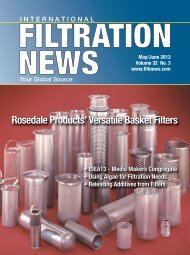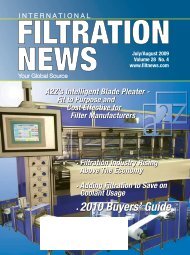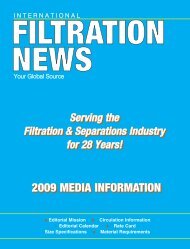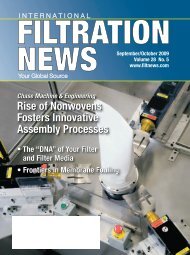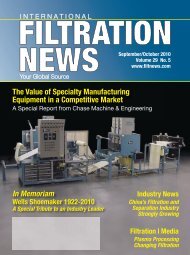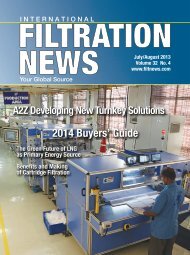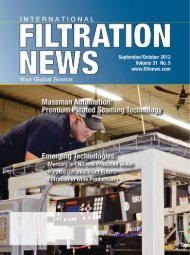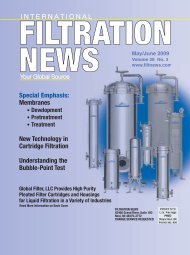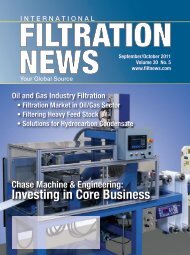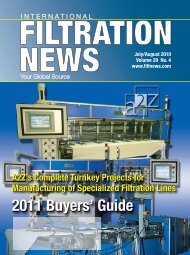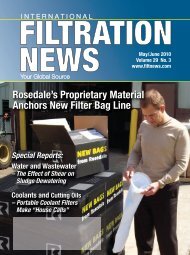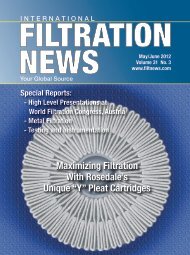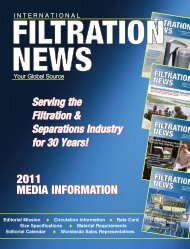Single or Dual Stage Municipal Drinking Water ... - Filtration News
Single or Dual Stage Municipal Drinking Water ... - Filtration News
Single or Dual Stage Municipal Drinking Water ... - Filtration News
- No tags were found...
Create successful ePaper yourself
Turn your PDF publications into a flip-book with our unique Google optimized e-Paper software.
I N T E R N A T I O N A LFILTRATIONNEWSYour Global SourceMay/June 2011Volume 30 No. 3www.filtnews.comShow Rep<strong>or</strong>t:Filtech 2011 - Largest EventSince Beginning<strong>Filtration</strong> – A GrowthMarket f<strong>or</strong> Synthetic FibersMembrane Filter RatingRosedale Products<strong>Single</strong> <strong>or</strong> <strong>Dual</strong> <strong>Stage</strong> <strong>Municipal</strong><strong>Drinking</strong> <strong>Water</strong> Filters
IN THIS ISSUEMay/June 2011, Vol. 30, No. 3<strong>Filtration</strong> | Marketing<strong>Filtration</strong> - A Growth Market f<strong>or</strong> Synthetic Fibers 4Association | <strong>News</strong>AFS Dixie Chapter Spring Meeting Held in N<strong>or</strong>th Carolina 11Cover St<strong>or</strong>y | Rosedale Products Inc.<strong>Single</strong> <strong>or</strong> <strong>Dual</strong> <strong>Stage</strong> <strong>Municipal</strong> <strong>Drinking</strong> <strong>Water</strong> Filters 12Membranes | TechnologyNew Methodology f<strong>or</strong> “Hyperfine” Membrane Filter Rating 14Membranes | WastewaterNew Membrane Bi<strong>or</strong>eact<strong>or</strong> System Eliminates <strong>Municipal</strong>Surcharges with Onsite Wastewater Treatment Facility 22Filter | TestingMeasuring the Perf<strong>or</strong>mance of a Filter Medium 28Show Rep<strong>or</strong>t | Filtech 2011Filtech 11 - Largest Event Since Beginning 31Published byINTERNATIONALMEDIA GROUP, INC.6000 Fairview Road, Suite 1200Charlotte, NC 28210 USAPhone: +1-704-552-3705Email: info@filtnews.comInternet: www.filtnews.comCarol and Arthur Brown, FoundersKlaas DeWaal, Publisher and CEOAntoinette DeWaal, Associate Publisherand Vice PresidentEdit<strong>or</strong>ial DepartmentKen N<strong>or</strong>berg, Edit<strong>or</strong> in Chief, Ken@filtnews.comAdrian Wilson, Intl. C<strong>or</strong>respondentChen Nan Yang, China C<strong>or</strong>respondentEdit<strong>or</strong>ial Advis<strong>or</strong>y Board, See page 3Administration DepartmentBarbara Ragsdale, Barbara@filtnews.comCirculation DepartmentCherri Jonte, Subscribe@filtnews.comAdvertising Sales RepresentativesUSA:Joan Oakley, Joan@filtnews.comDebra Klupacs, Debra@filtnews.comEurope:Werner Meier, w.meier@iff-media-chJudy Holland, jholland@textilemedia.com -*$ %"*# % ,,, ")$,(%# %(" '%*)(%, &%') ") '() +$) $ $$ $ ")') %$ . '%,)'!) %' -$)) '(#'$ ")' ) $ $" %' *" ) *$ &"' $! $ )' ")'(Cover courtesy ofRosedale ProductsChina:Zhang Xiaohua, ifj-china@yahoo.com.cnPublication Data<strong>Filtration</strong> <strong>News</strong> (ISSN:1078-4136) is publishedbi-monthly by International Media Group, Inc.Printed in U.S.A., Copyright 2011.This publication has a requested and controlledsubscription circulation - controlled by the staff of<strong>Filtration</strong> <strong>News</strong>; mailed bi-monthly as PeriodicalsPostage Paid (USPS 025-412) in Novi MI andadditional mailing offices.<strong>Filtration</strong> <strong>News</strong> is not responsible f<strong>or</strong> statementspublished in this magazine. Advertisers, agenciesand contributing writers assume liability f<strong>or</strong> allcontent of all submitted material printed andassume responsibility f<strong>or</strong> any claims arisingthere-from made against publisher.Mailing Address f<strong>or</strong> advertising,news releases and address changes:International <strong>Filtration</strong> <strong>News</strong>International Media Group, Inc.6000 Fairview Road, Suite 1200Charlotte, NC 28210 USAPhone: +1-704-552-3705Email: info@filtnews.comInternet: www.filtnews.comPOSTMASTER:Send address changes to:International <strong>Filtration</strong> <strong>News</strong>International Media Group, Inc.6000 Fairview Road, Suite 1200Charlotte, NC 28210 USA2 • June 2011 • www.filtnews.com
Edit<strong>or</strong>ial Advis<strong>or</strong>y BoardEdit<strong>or</strong>ial Board ChairmanEdward C. Greg<strong>or</strong>,ChairmanE.C. Greg<strong>or</strong> & Assoc. LLCTel: 1 704 442 1940Fax: 1 704 442 1778ecg@egreg<strong>or</strong>.comM&A, <strong>Filtration</strong> MediaHaluk Alper, PresidentMyCelx Technologies C<strong>or</strong>p.Tel: 770.534.3118Fax: 770.534.3117alper@mycelx.comOil Removal – <strong>Water</strong> and AirPeter S. Cartwright, PECartwright Consulting Co.cartwrightconsul@cs.comMembranes, RO,UltrafiltrationWu ChenThe Dow Chemical CompanyTel: 1 979 238 9943Fax: 1 979 238 0651Process <strong>Filtration</strong> (liquid/gas)Equipment and MediaPeter R. Johnston, PETel/Fax: 1 919 942 9092ddandp3@aol.comTest proceduresJim JosephJoseph MarketingTel/Fax: 1 757 565 1549josephmarketing@verizon.netCoolant <strong>Filtration</strong>Dr. Ernest MayerDuPont Co.Tel: 1 302 368 0021Fax: 1 302 368 1474ernest.mayer@usa.dupont.comGeneral Solid/Liquid Separationsin All AreasRobert W. McilvaineTel: 1 847 272 0010Fax: 1 847 272 9673mcilvaine@mcilvainecompany.comwww.mcilvainecompany.comMkt. Research & Tech. AnalysisHenry Nowicki, Ph.D. MBATel: 1 724 457 6576Fax: 1 724 457 1214Henry@pacslabs.comwww.pacslabs.comAbs<strong>or</strong>bent Testingand TrainingBrandon Ost, CEO<strong>Filtration</strong> GroupHigh Purity Prod. Div.Tel: 1 630 723 2900bost@filtrationgroup.comAir Filters, Pharmaceuticaland Micro-ElectronicGregg PoppeThe Dow Chemical CompanyTel: 1 952 897 4317Fax: 1 942 835 4996poppeg@dow.comIndustrial <strong>Water</strong>, Power,and Membrane TechnologyDr. Graham RidealWhitehouse Scientific Ltd.Tel: +44 1244 33 26 26Fax: +44 1244 33 50 98rideal@whitehousescientific.comFilter and Media ValidationAndy RosolGlobal <strong>Filtration</strong> Products Mgr.FLSmidth Mineralsandy.rosol@flsmidth.comTel: 1800 826 6461/1 801 526 2005Precoat/Bodyfeed Filter AidsClint ScobleFilter Media Services, LLCOffice: 1 513 528 0172Fax: 1 513 624 6993cscoble@filtermediaservices.comFabric Filters , Filter Media,Baghouse MaintenanceTony ShucoskyPall MicroelectronicsTel: 1 410 252-0800Fax: 1 410 252-6027tony_shucosky@pall.comCartridges, Filter Media,MembranesMark VanoverBayOne UrethaneSystems LLCMarketing ManagerTel: 1- 314-591-1792Email:mark.vanover@bayone.comPolyurethane SystemsScott P. Yaeger<strong>Filtration</strong> and SeparationTechnology LLCTel/Fax: 219-324-3786Mobile: 805-377-5082spyaeger@msn.comMembranes, New Techn.Dr. Bob BaumannAdvis<strong>or</strong>y BoardMember Emerituswww.filtnews.com • June 2011 • 3
<strong>Filtration</strong> | Market<strong>Filtration</strong> – A GrowthMarket f<strong>or</strong> Synthetic FibersBy Edward C. Greg<strong>or</strong><strong>or</strong> the inf<strong>or</strong>mation technology marketwith computers, iPods, cell phones,biotechnology and all the other growthindustries. However, few other manufacturingindustries hold a candle to filtrationsconsistent year-over-year growthand predictable profitability.INDA, the principal nonwoven industrytrade association in the USA,identified N<strong>or</strong>th American filtrationnonwoven roll good sales at $735 millionin 2007, as the largest nonwovenmarket segment in N<strong>or</strong>th America. In2011, sales are now approaching $800million in spite of the economic environment.Few would image that nonwovenfabrics f<strong>or</strong> filtration marketshave actually surpassed hygiene <strong>or</strong>medical drapes and gowns sales. Oneonly need look at what F<strong>or</strong>tune 500companies have and are paying to acquirefiltration and separations companiesin terms of multiples tounderstand the magnitude and ongoingstrength of the filtration industry.INDUSTRY MEGA TRENDSLeading trends include:Filter Cartridge from Meltblown Nonwoven Fabric Filter with Flu<strong>or</strong>opolymerFibers. Photo courtesy of Pall C<strong>or</strong>p<strong>or</strong>ation.It may surprise many to learn that thefiltration and separation industry isa growth industry and syntheticfibers have played a maj<strong>or</strong> role in its success.Over the last 20 years the filtrationand separations industry has grown at asteady rate of 2-6 percent per year beyondthe economy, whether the economyis up, down <strong>or</strong> stagnant. Certainmembrane market segments have a hist<strong>or</strong>icalgrowth of 5-10 percent, whereasothers are growing at 25 percent per year.Synthetic fibers f<strong>or</strong> use in filtration maynot be as glam<strong>or</strong>ous as medical devices4 • June 2011 • www.filtnews.com• Finer filtration, which continuouslycreates opp<strong>or</strong>tunities f<strong>or</strong> wider useand refinements of filtration mediaand new materials of construction• Steady predictable long-term growthf<strong>or</strong> most filter makers and suppliers• Consolidation has accelerated in thelast 4-5 years• Fibers are used widely in filtrationmedia• Environmental consciousness asusers seek solutions to containcontamination• One w<strong>or</strong>ld business as technologygrows and easily transcends b<strong>or</strong>ders;including emerging markets
<strong>Filtration</strong> | Market• Legislation and regulat<strong>or</strong>y controlsare increasing by the United StatesCongress, State and local officialswith enf<strong>or</strong>cement by the EPA andother agenciesLEGISLATING GROWTHTraditional drivers of industrygrowth revolve around the need toimprove product quality in manufacturingprocesses, prevention of undesirablecontainment and pollutionbef<strong>or</strong>e it occurs and remediation ofenvironmental damage. However, inrecent years, local, State and federalgovernment lawmakers and regulat<strong>or</strong>shave enacted legislation at an acceleratingrate. The CongressionalClean Air Act of 1990, with enf<strong>or</strong>cementby the EPA, was the first maj<strong>or</strong>piece of broad legislation with realteeth. It provided new regulations f<strong>or</strong>particulate and other contaminantcontrol. Since then, there has beenenf<strong>or</strong>cement of coal-based power generationfacilities including mercury,SOX and CO2 exhaust. Other legislationcontrols include oil and greasecontainment from parking lot st<strong>or</strong>mwater runoff. Beginning in 2007,OEM diesel vehicle soot and NOxemissions were regulated in the USAand by most other maj<strong>or</strong> territ<strong>or</strong>iesw<strong>or</strong>ldwide commencing in 2008. Enf<strong>or</strong>cementaccelerates again in the2014 time frame with vehicle retrofitlegislation in Calif<strong>or</strong>nia and implementationacross the USA f<strong>or</strong> use intug boats, locomotives, etc. Separately,the United States EPA enf<strong>or</strong>cementof Superfund Site cleanup andother less publicized enf<strong>or</strong>cementshave also become imp<strong>or</strong>tant fact<strong>or</strong>s.In addition to traditional industrygrowth, including emerging countries,legislation has become an imp<strong>or</strong>tantfact<strong>or</strong> and best friend of thefiltration and separations industry.FUNDAMENTAL CHARACTERISTICS• Industry growth out-paces theeconomy by 2-6 percent per yearwith certain segments perenniallygrowing at higher levels• Many filtration and separationcompanies achieve 25-50 percentgross profit margins• The customer base is extremelydiversified with over 30 maj<strong>or</strong>market segments• It’s still largely a raz<strong>or</strong> blade typebusiness with extensive replacementof filters• Liquid filtration and separation, as arule, tends to be m<strong>or</strong>e profitable thanair <strong>or</strong> gas filtration, although thereare exceptions in specific situations• Product cycles are long, often 10 - 20years and m<strong>or</strong>e• Upstream product development withcustomers is common, especially f<strong>or</strong>high-perf<strong>or</strong>mance end-uses• The better perf<strong>or</strong>ming companies6 • June 2011 • www.filtnews.com
<strong>Filtration</strong> | Markethousings, piping and othersystem materials and one beginsto realize why polymercompanies have paid attentionto opp<strong>or</strong>tunities in thismarket.Baghouse Filters from Hydroentangled Nonwoven using PET Fibers.Photo courtesy of PGI Nonwovens.have been acquired at 8-16 timesEBITDA over the last 10 years.MEDIA - THE HEART AND SOULMicrop<strong>or</strong>ous membrane filtrationmedia roll stock is a $2.5 - $3 billiondollar w<strong>or</strong>ldwide industry, dependingupon whose rep<strong>or</strong>t one buys. Membranemedia is but one component andabout 10 percent of the cost of an allplasticfilter cartridge, yet uses 2 layersof nonwoven fabric as pleat supp<strong>or</strong>t f<strong>or</strong>every one layer of membrane in the filtercartridge. This has an en<strong>or</strong>mous impacton the use of nonwovens andhighlights synthetic fiber contributionsto the filtration and separations industry.Synthetic nonwoven filtrationmedia roll stock sales are approximately$2 billion dollars w<strong>or</strong>ldwide.This value does not include in excess of$1 billion w<strong>or</strong>ldwide f<strong>or</strong> cellulosic wetlaidfiltration media, typically used inautomotive and truck engine air intake,fuel and oil filters and a variety of otherapplications. Add in the hundreds ofmillions if not billions of dollars in syntheticmonofilament and multifilamentyarns, roving and staple fibers, plasticcartridge supp<strong>or</strong>t frames, end caps,8 • June 2011 • www.filtnews.comPOLYPROPYLENE FIBERSPolyolefin, and in particular,polypropylene, is one ofthe three main w<strong>or</strong>kh<strong>or</strong>sesynthetic fibers of the industry.Polypropylene fibers arewidely specified in filtrationmedia where chemical <strong>or</strong> solventresistance is imp<strong>or</strong>tant.Polypropylene monofilamentand multifilament woven fabrics,meltblown, spunbondand thru-air bonded fabricsand spray spun (meltblown)cartridges are widely usedwith a variety of constructionsin coolant filtration, paintspray booths, demisters, filter presses,spring wound cartridges, dewateringbelts and meltblown fabrics f<strong>or</strong> vacuumcleaner bags. Wetlaid polypropylenefabrics are used as membrane substratesf<strong>or</strong> certain cleanable RO/UFmembranes spiral wrap modules.Polypropylene is a leading polymer andwidely used fiber component of HVACair filters, taking advantage ofpolypropylene’s negative triboelectricproperty f<strong>or</strong> enhanced particle capture.POLYESTER FIBERSPolyester fibers are used primarily innonwoven fabric and monofilamentwoven fabric f<strong>or</strong> a variety of applications,including filtration media municipalsludge dewatering to criticalmedia applications from open heart bypasssurgery to hernia patches. Polyesterand co-polyester fibers in the f<strong>or</strong>mof a wetlaid substrate are used as supp<strong>or</strong>tmaterial f<strong>or</strong> RO/UF membranesand/<strong>or</strong> binder fibers combined with cellulose<strong>or</strong> glass fibers f<strong>or</strong> specialty applications.Polyester yarns dominateknitted channel fabrics in spiral woundmodules. On the nonwoven fabric side,polyester-based media is used in swim-
Association | <strong>News</strong>AFS Dixie Chapter Spring Meeting Held in N<strong>or</strong>th CarolinaBy Ed Greg<strong>or</strong>The Dixie chapter of the American<strong>Filtration</strong> and SeparationsSociety (AFS) held a two-dayspring chapter meeting and conferenceMarch 9-10 at Purolat<strong>or</strong>-Facet in Greensb<strong>or</strong>o,N<strong>or</strong>th Carolina. The event wasmarked with a good dose of netw<strong>or</strong>king,camaraderie and the opp<strong>or</strong>tunity to makenew industry acquaintances in the best ofsouthern fashion. The event had 12 presentationsover both days covering thetopic of Self-Cleaning, Cleanable andReusable Filters f<strong>or</strong> Liquids and Gas.Chapter members went on a very inf<strong>or</strong>mativetour of the Childress Wineryand had a unique educational experience.Interestingly, participants learned how filterpresses are being replaced by ceramictangential (crossflow) filtration in winemaking, even with smaller wineries, suchas Childress, who share the equipmentduring the season. The head wine makerwas every bit as much of a “filter man” asanyone of the visit<strong>or</strong>s, with his in-depthknowledge of the vast variety of industryfilters and filtration processes. This obviouslycontributed greatly to the experienceand appreciation of the tour andwinemaking process. Of course, few ofthe participants left without a chance totaste the wine and a visit to the wine shop,taking home the fruits in a bottle <strong>or</strong> two.A netw<strong>or</strong>king reception followed laterin the day with a Dixie chapter meetingincluding the election of three new officersgoing f<strong>or</strong>ward: Todd Furbee, DeltaPure <strong>Filtration</strong> as Dixie chapter president;Rob Prichard, Fiberweb, chapter vicepresident; and Brad Zeigler, Sefar, chaptersecretary/treasurer. An in-depth slide presentationfollowed on the topic of reusablefiltration media, covering six of the mostcommon choices and end use market opp<strong>or</strong>tunities.F<strong>or</strong> those who thought theindustry was largely made up of disposablefilters, a dose of just how broad theindustry is and how many opp<strong>or</strong>tunitiesexist f<strong>or</strong> higher-margin business wasgleaned, and perhaps a new mindset fromMembers of the Dixie chapter of the AFS at the spring meeting.the comments after the meeting.On the second day, participants met inthe conference room at Purolat<strong>or</strong>-Facetwith 11 presentations on reusable and“green” filtration media, filters and systemsincluding insight into two brandnewemerging technologies, beyondtraditional industry offering with plenty ofchances f<strong>or</strong> Q&A. One of the speakers ranf<strong>or</strong> the U.S.House of Representativesin2010, but lost, althoughhe said hewould try againin 2012. Most attendeesleft thetwo days with anumber of newprofessional contactswith severalasking about futureDixie chaptermeetingsand/<strong>or</strong> AFS C<strong>or</strong>p<strong>or</strong>ateSpons<strong>or</strong>shipf<strong>or</strong> theirc o m p a n i e s ,which was an allaroundpositivesign of success.Special thanksgo to exiting officers– Cecil Baty,H.C. Warner,chapter president;Don Olds,Olds <strong>Filtration</strong>,vice president;www.filtnews.com • June 2011 • 11and Ge<strong>or</strong>ge Stone, Jack Daniels (retired),secretary/treasurer – f<strong>or</strong> their dedicated eff<strong>or</strong>tsand stewardship over the years inkeeping the Dixie chapter strong and oneFNof the leading AFS chapters.AFS’ next calendar event is the 2011Fall Focus Conference in Houston, TX,October 17-20.F<strong>or</strong> m<strong>or</strong>e inf<strong>or</strong>mation visit: www.afssociety.<strong>or</strong>g
Cover St<strong>or</strong>y | Rosedale Products Inc.<strong>Single</strong> <strong>or</strong> <strong>Dual</strong> <strong>Stage</strong><strong>Municipal</strong> <strong>Drinking</strong> <strong>Water</strong> FiltersBy Dan M<strong>or</strong>osky, Rosedale Products, Inc.Most Americans take safe,contaminant-free drinkingwater f<strong>or</strong> granted. Yetwaterb<strong>or</strong>ne disease outbreaks dooccur, with most directly related tocontaminated surface water <strong>or</strong>groundwater with surface watersources. Violations of the Safe <strong>Drinking</strong><strong>Water</strong> Act affect millions of Americansthrough water provided to thepublic in restaurants, hotels, campgroundsand, of course, our homesfrom our municipal water system.Organisms such as cryptosp<strong>or</strong>idiumand Giardia Lamblia can cause diarrhea,abdominal cramps, nausea, occasionalvomiting, and low-grade fever.Surface water is exposed to contaminationby cryptosp<strong>or</strong>idium and Giardiafrom sewage and animal wastes.Additional <strong>or</strong>ganisms, such as Cryptosp<strong>or</strong>idium,threaten water suppliesand produce diseases with serioussymptoms. Particularly at risk, are thevery young, the aged, and the immunologicallychallenged.The federal government has providedthe Surface <strong>Water</strong> Treatment Rule(SWTR), which specifically requiresthe control of Giardia in public watersupply systems. The SWTR establishesperf<strong>or</strong>mance criteria f<strong>or</strong> water treatmentto ensure a 99.9 percent reductionof cysts in water supplies.Left to right: <strong>Single</strong> <strong>Stage</strong> Model 8302P; <strong>Single</strong> <strong>Stage</strong> Model NCO8135; Cutawayof 740 Cartridge –The “Y” pleat maximizes effective surface area.TWO FILTRATION SYSTEMSRosedale has developed two longlasting,effective water filtration systemsthat meet the SWTR and protocolsf<strong>or</strong> most states. The <strong>Single</strong> <strong>Stage</strong>System is excellent f<strong>or</strong> smaller applications.The <strong>Dual</strong> <strong>Stage</strong> System can be designedto filter water up to 500 GPM.12 • June 2011 • www.filtnews.com<strong>Single</strong> <strong>Stage</strong> GiardiaCryptosp<strong>or</strong>idium RemovalThe Model 8302P and NCO8135high-capacity filter housings offer anexceptional value in Giardia Cryptosp<strong>or</strong>idiumRemoval applications. Thesystem is approved f<strong>or</strong> use in Oregonand has met all the EPA LT2 guidelines.The single housing and element providea large containment capacity combinedwith a rugged stainless steel designrated to 150 psi. It inc<strong>or</strong>p<strong>or</strong>ates an eyenutcover that is easily removed, reducingtime spent on cartridge change-out.SINGLE STAGE FILTER ELEMENTSPS-740-PPP-356 elements are manufacturedin a unique “Y” pleat arrangementthat optimizes physical size andmaximizes effective surface area. Thelarge surface area provides a low fluidflux rate maximizing dirt containment.This provides a 3 LOG cryptosp<strong>or</strong>idiumremoval (see chart) when usedalone. The optimum flow rate f<strong>or</strong> thesystem is 10 gallons per minute (GPM).The element fits into the RosedaleNCO8135 housing <strong>or</strong> can retrofit existing8302P housings with an adapt<strong>or</strong>basket. The end caps are heat sealedf<strong>or</strong> high efficiency perf<strong>or</strong>mance. Theo-ring seal insures sealing and eliminatesbypass.
Retrofit Current SitesExisting installations using theRosedale 8302P and PS-520-PPP-241<strong>or</strong> GLR-PO-825-2 can easily convert toa single housing by installing the PS740 adapt<strong>or</strong> basket.This is accomplished by replacingthe perf<strong>or</strong>ated filter basket with theadapt<strong>or</strong>. The solid side basket acceptsthe new PS 740 cartridge and directsthe flow through the unit.Typical application, from left to right (below): Optional Roughing Pre-Filter Bag, Filter PS-520-PPP-241, Final Filter GLR-PO-825-2.<strong>Dual</strong> <strong>Stage</strong> GiardiaCryptosp<strong>or</strong>idium RemovalRosedale has developed an effectivewater filtration system that meets theSWTR and protocols f<strong>or</strong> most states. Twostage systems are approved in Calif<strong>or</strong>nia,Washington, Oregon, Vermont, Maineand Minnesota. This system offers adual-stage design that filters out largercontaminants bef<strong>or</strong>e filtering out disease-producingmicro<strong>or</strong>ganisms. Thisextends the life of the element that filtersout the Giardia and Cryptosp<strong>or</strong>idium.The system consists of two highqualityRosedale Model 8 housings(pressure vessels), placed in series.• The first stage is fitted with aPS-520-PPP-241 bag/cartridge.• The second stage is Rosedale’sGLR-PO-825-2 bag/cartridge.An optional third Roughing Filter isrecommended, and helps extend elementlife f<strong>or</strong> all the filters (see TypicalApplication photo).This provides a 2 LOG cryptosp<strong>or</strong>idiumcredit (see chart) whenused in tandem. The optimum flow ratef<strong>or</strong> the system described is 13 gallonsper minute (GPM).DUAL STAGE FILTER ELEMENTSPre-filter (Optional)All graded-density bags are constructedof nine-layers of polypropylenemicro fibers and standard fibersthat are variably calendered. Heavydutyhandles are sewn and turned insideout to avoid leakage and enhancetheir pressure capacities.Final Filter (2 Choices)1. The Rosedale GLR-PO-825-2 elementhas 26 layers of high-efficiencypolypropylene micro fiber material, encasedin a rigid supp<strong>or</strong>t cage. The initiallayers are pre-filtration levels, while thenext several layers filter the cystpathogen itself. The final barriers preventany material from migrating intothe effluent. All GLR units have a speciallydesigned gasket to assure a bypass-proofseal. All seams and joints areheat sealed to prevent leakage. The inside-outflow design traps contaminantson the inside, reducing thepossibility of downstream contaminationduring change-out and simplifyingthe service process. NSF 61 listed.2. The PS-520-PPP-241 filters aremanufactured in a “Y” pleat arrangementthat optimizes physical size andmaximize effective surface area. Thelarge surface area provides a low fluidflux rate maximizing dirt containment.This means element life is extended(NSF 61 listed).Rosedale manufactures filtration systemsf<strong>or</strong> larger applications that can filterwater up to 500 GPM. Multiple designsFNare available to meet clients needs.www.filtnews.com • June 2011 • 13F<strong>or</strong> m<strong>or</strong>e inf<strong>or</strong>mation contact:Rosedale Products Inc.P.O. Box 10853730 West Liberty RoadAnn Arb<strong>or</strong>, MI 48106Tel: 1-800-821-5373, 1-734-665-8201Fax:1-734-665-2214Website: www.rosedaleproducts.com
Membranes | TechnologyNew Methodology f<strong>or</strong> “Hyperfine”Membrane Filter RatingBy Tony Shucosky, Patrick Conn<strong>or</strong> and Takehito Mizuno, Pall MicroelectronicsThere are a number of industriesin which microp<strong>or</strong>ousmembrane filtration is an enablingtechnology. Membrane filtersallow users to remove microscopic“killer” particles that would otherwisebe detrimental <strong>or</strong> even destructiveto their processes. A primeexample is leading edge integratedcircuit production. Particles as fine as20 nanometers i can intrude fromprocess streams contacting semiconduct<strong>or</strong>wafers and potentially causingfailure of chips produced from thesewafers. Manufacturers of filters intendedf<strong>or</strong> these processes must producefilters capable of capturing suchfine particles, as well as providingsome quantitative indication of captureefficiency at these small sizes.The current state of particle countingtechnology exhibits suitable sensitivityonly down to about 30 nm. Thislimits the extent to which membraneproducers can provide a product witha reliable rating finer than 30 nm.Membrane producers have commonlyaddressed this obstaclethrough the use of indirect methodsof assessing particle retention below30 nm. F<strong>or</strong> example, determinationof the pressure (usually referred to asthe “KL” value) at which liquid retainedin the p<strong>or</strong>ous structure by surfacetension is expelled has beenshown to c<strong>or</strong>relate with retention ii .Other methods include determinationsof p<strong>or</strong>e size distribution byp<strong>or</strong>osimetry <strong>or</strong> actual measurementsof p<strong>or</strong>e size by microscopy iii,iv . Evenwhere there is a sound physical rationalef<strong>or</strong> such methods, they areonly capable of providing a rough,qualitative indication of the size ofparticle the membrane can capture.There is a need to develop new techniquesthat circumvent the limitationsof particle counters and permitquantitative filter rating. This paperdescribes a new technique that candemonstrate quantitative membraneretention of particles as fine as 10 nmusing colloidal gold as a model particlef<strong>or</strong> challenging the membrane.This new method makes use ofthese key facts regarding colloidalgold:1. It is available in a variety ofsizes from < 5 nm to > 200 nm.2. It can be obtained as suspensionsof particles that are very nearlyspherical.3. As the colloid particles consistof essentially pure gold, their level insuspension can be measured accuratelyand over a wide dynamic rangeby inductively coupled plasma massspectrometry (ICP-MS).4. Suspensions of colloidal goldexhibit the necessary degree of colloidalstability required f<strong>or</strong> testingmembrane retention.5. Because gold is conductive, it isnot necessary to apply a potentiallysize-altering conductive coating f<strong>or</strong>electron microscopy imaging, whereneeded.In developing this technique, PallMicroelectronics addressed the followingquestions that are imp<strong>or</strong>tantwith respect to the testing and ratingof filters:• Do the particles exhibit therequisite unif<strong>or</strong>mity of shape andsize required?• Does the technique showcomparability with other m<strong>or</strong>eestablished techniques, e.g., theuse of single-sized PSL beads?14 • June 2011 • www.filtnews.com• Does the technique produceresults that are consistent withexpectations based on predictivetechniques, e.g., c<strong>or</strong>relation ofretention to membrane KLvalues?• Is it possible to apply thetechnique reliably f<strong>or</strong>membranes producedfrom various materials (e.g.,PTFE, polyamide, polyethylene)?• Can unintended ads<strong>or</strong>ptive <strong>or</strong>agglomerative effects thatartificially enhance retentionefficiency be avoided throughidentification of proper testconditions?As described below, the company’sevaluation of the new technique hasdemonstrated its viability in terms ofall of these issues.EXPERIMENTALColloidal Gold: Materialsand CharacterizationAll of the testing described herewas conducted using colloidal goldobtained in various sizes (EMGCgrade: 10, 20, 30 nm), from BBI(Cardiff, U.K.). The actual particlesize distribution f<strong>or</strong> the differentsizes used was determined using dynamiclight scattering (DLS, modelZetasizer Nano ZS, Malvern, W<strong>or</strong>cestershire,U.K.), with supplementalconfirmation of size and shape viafield emission scanning electron microscopy(FESEM, model S-5200, Hitachi,Tokyo, Japan). F<strong>or</strong> referencepurposes, 33 nm PSL beads were obtainedfrom Duke Scientific (PaloAlto, CA, U.S.). Detection of the levelof elemental gold in suspensions ofcolloidal gold in deionized water wasdetermined using ICP-MS (model
HP-4500, Agilent, SantaClara, CA, U.S.), usinga standard solution ofchl<strong>or</strong>oauric acid,HAuCl4 (Wako, Osaka,Japan) f<strong>or</strong> calibration.Membrane TestingRetention testing offiltration membraneswas carried out using47 mm disks of varioustypes of media: polytetr a f l u o r o e t h y l e n e(PTFE) possessing ratingsof 20 nm and30 nm, high density polyethylene(HDPE) with ratings of 10 nm and30 nm, and nylon-6,6 rated at 20 nmand 40 nm. Where any medium isdesignated as having a rating finerthan 30 nm, this value was obtainedby extrapolating the c<strong>or</strong>relation observedbetween KL value of themedium (in pure isopropanol) andsize rating as determined by quantitativecounting methods available at30 nm and larger. This is depicted inFigure 1. Rating of Membrane via Extrapolationof Curve f<strong>or</strong> KL Data vs. Measured RetentionFigure 1 f<strong>or</strong> the specific caseof PTFE.As necessary to achievewettability of the medium,disks were prewet with pureisopropanol and installed in astandard 47 mm disk holder. Thedisk holder was plumbed to a 10” filterhousing, functioning as a pressurevessel, which contained the colloidalgold suspension challenging themembrane. The disk holder, pressureFigure 2. Schematic of test set-upvessel, and all other wetted surfaceswere of perflu<strong>or</strong>oalkoxy (PFA) constructionto avoid potential electrochemicalinteractions that mightoccur between gold and metal surfaces.A constant pressure was main-
Membranes | Technologytained above the suspension in thevessel, adjusted to an appropriatelevel to allow a constant flow rate of5 mL/min to pass through the membrane,as established by monit<strong>or</strong>ingthe weight of effluent from the membraneover time. The experimentalset-up is depicted schematically inFigure 2.The typical concentration of goldemployed f<strong>or</strong> testing was 500 µg/L(500 ppb <strong>or</strong> 0.5 ppm), although additionaltests were run at lower concentrationswhere evaluation of theimpact of particle level (which can beeasily shown to be prop<strong>or</strong>tional tolevel of elemental gold f<strong>or</strong> singlesizedparticles) on membrane retentioncharacteristics. The actual levelof elemental gold in the challenge solutionwas confirmed by ICP-MS. Inconducting actual tests, an initialvolume of effluent was discarded soas to ensure that results reflectedonly steady-state operation. Afterthis initial period, sufficient effluentwas collected f<strong>or</strong> analysis of goldlevel by ICP-MS. Particle removal efficiencyis defined as:where Cpart. refers to the concentrationof particles in the influent to <strong>or</strong>effluent from the filter membrane.F<strong>or</strong> challenge testing involving single-sizedparticles, Cpart. can be replacedby CAu the level of goldmeasured by ICP-MS, as the parametersrelating Cpart. to CAu cancel in theequation above.Evaluation of Chemical Modificationof Colloidal Gold on Particle CaptureWith respect to HPDE andnylon-6,6 membranes, it was recognizedthat colloidal gold might exhibitexcessive ads<strong>or</strong>ption on thesematerials, thereby leading to artificiallyhigh degrees of particle removal.To evaluate this aspect, aseries of colloidal gold suspensionswere prepared to which was addedbetween 0.5 and 10 ppm of two differentstabilizers known to be capableof bonding to the surface of thegold colloid particle. Based on inf<strong>or</strong>mationgleaned from studies of thebehavi<strong>or</strong> of colloidal gold in the presenceof various stabilizing ligands,Pall chose to evaluate the impact ofmercaptosuccinic acid (Wako) oncapture of colloidal gold by HDPE,and of 2-amino-2-hydroxymethyl-1,3-propanediol (Wako) f<strong>or</strong> the caseFigure 3. Particle size distribution ofvarious sizes of colloidal gold andPSL beads16 • June 2011 • www.filtnews.com
Figure 5. Comparison of Removal Efficiencies of 20 nm PTFE Membrane Testedwith Various Concentrations of 30 nm Colloidal Gold and 33 nm PSL Beadsto exhibit m<strong>or</strong>e variation than thec<strong>or</strong>responding size of colloidal gold,and even of the smallest size of colloidalgold employed. Collections ofcolloidal gold deposited onto asmooth surface, f<strong>or</strong> each of the threesizes used, when imaged by FE-SEM,were found to be very unif<strong>or</strong>m, withminimum deviation from spherical,as seen in Figure 4 (a,b,c).These evaluations demonstratethat colloidal gold as fine as 10 nm insize exhibits the requisite characteristicsin terms of approach toFigure 4. FE-SEM Images, 500kXmagnification, of 10 nm (top), 20 nm(middle), and 30 nm (bottom) colloidalgold particlesof nylon-6,6. Membrane testing withstabilized suspension of colloidalgold was otherwise conducted in thesame manner as described earlier.(Based on the known properties ofPTFE, it was not considered necessaryto employ stabilizers in tests involvingPTFE membrane.)RESULTS AND DISCUSSIONSize Distribution and M<strong>or</strong>phologyof Colloidal GoldAs depicted in Figure 3, the particlesize distributions of the colloidalgold suspensions used in this studyexhibit minimal variation from thevalues provided f<strong>or</strong> them by the manufacturer,when analyzed by DLS. Inthis graph, the PSD of 33 nm PSLbeads has been overlaid, and is foundwww.filtnews.com • June 2011 • 17
Membranes | TechnologyFigure 6.RemovalEfficienciesf<strong>or</strong> VariousPTFEMembranesChallengedwith 20 nmColloidalGold18 • June 2011 • www.filtnews.commonodispersity of particle size andunif<strong>or</strong>mity of particle m<strong>or</strong>phology tobe used in a successful manner f<strong>or</strong>the rating of filtration membranesexpected to be capable of retentiondown to 10 nm.Comparison of Retention TestingUsing Colloidal Gold and PSL BeadsWhile the af<strong>or</strong>ementioned limitationsin terms of suitable sub-30 nmPSL beads precludes comparison ofretention test results below that size,it was considered appropriate to establishcomparability of the gold colloidtechnique to the existing PSLmethodology that uses standard lightscattering particle counting instrumentationat 30 nm. F<strong>or</strong> this comparison,PTFE medium which hadbeen assigned a 20 nm rating (per theKL c<strong>or</strong>relative method mentionedearlier) was tested at various incidentparticle levels between about 1 108and 4 108 particles/cm2 of 33 nmPSL beads and 30 nm colloidal gold.As depicted in Figure 5, the twomethods yield essentially identicalresults, an indication that the goldcolloid method is suitable in terms ofquantitative testing of particulate retentionas compared to a well establishedtechnique.Comparability of Gold Colloid toPredictive TechniquesIt has been noted that in the absenceof definitive means of establishingthe quantifiable removal ofparticles of a given size, membraneproducers may utilize indirect techniquesto assign a size rating atwhich some reasonable reduction inlevel of particles ought to occur. F<strong>or</strong>some of these methods, most especiallythe extrapolation of ratingbased on membrane KL, the strongdegree of c<strong>or</strong>relation over a wide sizerange within which direct determinationof particle removal is possiblesuggests that predicted values oughtto have some validity, even if onlysemi-quantitative.PTFE membrane exhibiting a KLvalue suggesting that the membrane
Figure 7. Schematic representation of mercaptosuccinic acid (left) and2-amino-2-hydroymethyl-1,3-propanediol (right) covering surface of colloidalgold particles (CH bonds omitted f<strong>or</strong> clarity)ought to provide reasonable retentionat 20 nm was subjected to testingwith a 500 ppb suspension of20 nm colloidal gold without the additionof any stabilizers. It was foundthat essentially 100 % removal wasachieved f<strong>or</strong> the membrane assigneda 20 nm rating by indirect means.Furtherm<strong>or</strong>e, a PTFE membrane ofsimilar type, but possessing lower KLvalue and f<strong>or</strong> which a rating of 30 nmhad been previously assigned usingdirect particle counting methodology,was also tested using 20 nm colloidalgold. In this testing, retention at20 nm was found to be 82%. Researchersadditionally tested twoother PTFE membranes that hadbeen assigned 30 nm ratings, but f<strong>or</strong>which no inf<strong>or</strong>mation was availablewith respect to assignment of thisrating, with 20 nm colloidal gold retentionfound to be 71% and 55% f<strong>or</strong>these two membranes. These results,depicted in Figure 6, indicate thatthe colloidal gold technique producesresults that are in line with expectationswith respect to particleremoval of filters known by othermeans to possess intrinsically differentretention characteristics. Theyalso suggest that, there can be somevariation in actual perf<strong>or</strong>manceamong membranes given the samerating, even at 30 nm.been applied to the testing of PTFE,HDPE, and nylon-6,6 membranesthat have been assigned ratings finerthan 20 nm based on indirect techniques.F<strong>or</strong> all of these media, it wasfound that the technique returned anindication of essentially complete retentionof the 10 nm (f<strong>or</strong> HDPE) <strong>or</strong>20 nm (f<strong>or</strong> PTFE and nylon-6,6) colloidalgold with which they werechallenged. These results indicatethat the technique is suitable f<strong>or</strong> establishingretention characteristicsbelow 30 nm f<strong>or</strong> various membranematerials known to have disparatechemical nature and m<strong>or</strong>phology oftheir p<strong>or</strong>ous structure.Additionally, Pall compared the retentionof the 10 <strong>or</strong> 20 nm gold colloidparticles f<strong>or</strong> two different gradesof each material. As shown inTable 1, the technique was capable ofshowing a difference between retentioncharacteristics f<strong>or</strong> all three typesof material. This is further indicationof the general applicability of thetechnique f<strong>or</strong> a variety of differentmembrane materials.F<strong>or</strong> the HDPE and nylon-6,6 membranes,the listed value in Table 1. wasthe lowest observed in testing withvarious levels of stabilizer added, asdiscussed in the next section.Effect of Ligand Addition f<strong>or</strong>Avoidance of the Impact of Ads<strong>or</strong>ptionThe typical manner in which colloidalgold are prepared tends to produceparticles that will possess anads<strong>or</strong>bed layer of citric acid, a conditionthat enhances their colloidal sta-Applicability of Gold Colloid Techniquef<strong>or</strong> Different Membrane MaterialsThe gold colloid technique haswww.filtnews.com • June 2011 • 19
Membranes | TechnologyFigure 8. Impact of addition of stabilizer on retention of colloidalgold particles smaller than assigned rating of membraneFigure 9. Impact of the addition of stabilizer on retention of colloidalgold particles of the same size as assigned filter ratingbility v . As such, no special additivesare necessary to maintain their suspensionin water. In spite of this colloidalstability away from themembrane surface, colloidal and interfacialchemical considerations predictthat f<strong>or</strong> the sizes of particleencountered here, HDPE andnylon-6,6—but not PTFE—could beexpected to have some ads<strong>or</strong>ptive effecton the colloidal gold particles.This condition might tend to resultin artificially high retention levels f<strong>or</strong>particles smaller than the assignedrating of a membrane.Various studies have shown thatthe surface properties of colloidalgold can be modified through the ads<strong>or</strong>ptionof thiol <strong>or</strong> amino functionalgroups vi,vii,viii,ix . In evaluating severalpossible candidates it was found thatmercaptosuccinic acid (MSA) wouldbe the most appropriate stabilizer f<strong>or</strong>testing of the HDPE membrane,while 2-amino-2- hydroxymethyl-1,3-propanediol was suitable f<strong>or</strong> testingof the nylon-6,6 membrane.Figure 7 provides a schematic representationof the ads<strong>or</strong>ption of theseligands via sulfur and nitrogen, respectively,f<strong>or</strong> the two compounds.As can be seen in Figure 8, the20 • June 2011 • www.filtnews.compresence of stabilizer had a significantimpact on retention, with 30 nmHDPE membrane and 40 nmnylon-6,6 membrane capable of exhibitingvery significant retention ofcolloidal gold smaller than the membranerating in the absence of stabilizer,but exhibiting a reduction in thepresence of stabilizer. On the otherhand, the 10 nm HDPE membraneand 20 nm nylon-6,6 membranes eachexhibited minimal reduction of retentionwhen challenged with 10 nm and20 nm colloidal gold, respectively, regardlessof the level of stabilizer presence.These findings are significant inthat they suggest that the techniquecan be optimized to minimize the unpredictableimpact of chemical effectsand provide a conservative indicationof capture that is primarily based onthe typical filtration mechanisms(e.g., sieving and inertial impaction).
CONCLUSIONSPall Microelectronics has developeda technique involving colloidal goldthat allows quantitative determinationof the removal by membrane of particlesas fine as 10 nm. This permits theassignment of size ratings below30 nm by a direct, operational measurementtechnique f<strong>or</strong> today’s nextgenerationfiltration membranes. Thisrepresents a significant advancementover the indirect membrane ratingmethods that analytical limitationshave necessitated to this point f<strong>or</strong> assigningratings finer than 30 nm. Thetechnique has been shown i.) to utilizea material available with the necessaryunif<strong>or</strong>mity of size and shape to be appropriatef<strong>or</strong> the rating of filtrationmembranes, ii.) to provide resultsconsistent with expectations based onother direct and indirect methods, iii.)to be applicable to a variety of differentmembrane materials and iv.) to becapable of optimization to ensure thatads<strong>or</strong>ption effects that might lead toartificially high retention are addressed,thus providing a suitably conservativeindication of membrane ratingexpected to be based on typicalparticle capture mechanisms.FNF<strong>or</strong> m<strong>or</strong>e inf<strong>or</strong>mation contact:Tony Shucosky, Pall MicroelectronicsEmail: Tony_Shucosky@pall.comREFERENCESi) International Technology Roadmapf<strong>or</strong> Semiconduct<strong>or</strong>s, 2009 edition.ii) Pall, D.B., Kirnbauer, E.A,, andAllen, B.T., “Particulate retention bybacteria retentive membrane filters,”Colloids and Surfaces, 1(3-4), 235(1980).iii) Sanz, J.M., Jardines, D., Bottino,A., Capanelli, G., Hernandez, A., andCalvo, J.I., “Liquid–liquid p<strong>or</strong>ometryf<strong>or</strong> an accurate membrane characterization,”Desalination, 200(1-3), 195(2006).iv) Wyart, Y., Ge<strong>or</strong>ges, G., Deumi, C.,Amra, C., and Moulin, P., “Membranecharacterization by microscopicmethods: Multiscale structure,” J.Membrane Sci., 315(1-2), 82 (2008).v) Kunze, J., Burgess, I., Nichols, R.,Buess-Herman, C., and Lipkowski, J.,“Electrochemical evaluation of citrateads<strong>or</strong>ption on Au(111) and thestability of citrate-reduced gold colloid,”J. Electroanalytical. Chem.,599(2), 147 (2007).vi) Schlenoff, J.B., Li, M., and Ly, H.,“Stability and self-exchange in alkanethiolmonolayers,” J. Am. Chem.Soc. 117(50), 12528 (1995).vii) Stoeva, S. I., Smetana, A.B.,S<strong>or</strong>enson, C.M., and Klabunde, K.J.,“Gram-scale synthesis of aqueousgold colloids stabilized by variousligands,” J. Colloid. Interface Sci.,309(1), 94 (2007).viii) Chen, S., and Chimura, K.,“Synthesis and characterization ofcarboxylate-modified gold nanoparticlepowders dispersed in water,”Langmuir, 15(4), 1075 (1999).ix) Yonezawa, T., Yasui, K., andKimizuka, N., “Controlled f<strong>or</strong>mationof smaller gold nanoparticles by theuse of four-chained disulfide stabilizer,”Langmuir, 17(2), 271 (2001).www.filtnews.com • June 2011 • 21
Membranes | WastewaterNew Membrane Bi<strong>or</strong>eact<strong>or</strong> SystemEliminates <strong>Municipal</strong> Surcharges withOnsite Wastewater Treatment FacilityBy Jim McMahonGolden Flake Snack Food’s membrane bi<strong>or</strong>eact<strong>or</strong> in Birmingham, Alabama.The membrane bi<strong>or</strong>eact<strong>or</strong>(MBR) system, designed andbuilt by ADI Systems Inc.,treats up to 400,000 gallons per day ofraw snack food wastewater using advancedmembrane bi<strong>or</strong>eact<strong>or</strong> technologyf<strong>or</strong> liquid-solid separation,reducing suspended solids and biochemicaloxygen demand to less than 2milligrams per liter, eliminating$100,000 per month in municipalwastewater surcharges, and releasing250 gallons per minute of treated, filtered,oxygenated water into the localwatercourse ecosystemGolden Flake Snack Foods (GoldenFlake) located in Birmingham, Alabama,was faced with a tough decision;either come up with a solution to stemthe escalating municipal wastewatersurcharges it was being assessed, <strong>or</strong>move its 300,000 square-foot snackfood processing plant out of the countyto stem the significantly rising costs. In1998, the plant was paying $800 to$1,000 per month to Jefferson Countyin surcharges f<strong>or</strong> decanting its 100,000to 350,000 gallons of wastewater intothe county’s municipal sewer system.By 2008 that figure had escalated to$100,000 per month in surcharges f<strong>or</strong>the same daily discharged wastewater22 • June 2011 • www.filtnews.comflow rate, with county projections thatthe rate would most likely raise to$250,000 per month within the nextfive years.Given the fact that 68 percent ofGolden Flake’s 250-plus w<strong>or</strong>k f<strong>or</strong>celives within a 13-mile radius of theplant, the company preferred to keepits 80-year-old headquarters and mainmanufacturing facility in Birmingham,and find a solution to reduce <strong>or</strong> eliminatethe surcharges. This meant, inessence, getting off of the county sewersystem.The Alabama Department of EnvironmentalManagement, which sets
standards f<strong>or</strong> wastewater regulationswithin the state, made it clear that ifGolden Flake could reach prescribedTSS (total suspended solids), BOD(biochemical oxygen demand), NH3-N(ammonia-nitrogen) and DO (dissolvedoxygen) concentrations, it couldreceive a discharge permit to conveytreated effluent directly into a creekthat runs along the perimeter of itsproperty, and bypass the JeffersonCounty sewer system altogether.GOLDEN FLAKE’S WASTEWATERThe Golden Flake plant manufacturesand distributes a full line of snackfood items, including potato chips, t<strong>or</strong>tillachips, puffed c<strong>or</strong>n, c<strong>or</strong>n chips,cheese puffs, cheese curls, onion ringsand p<strong>or</strong>k skins. P<strong>or</strong>k skins are its specialty,producing over a dozen varietiessuch as Louisiana Hot Sauce P<strong>or</strong>kSkins®, Hog Hides P<strong>or</strong>k Skins®, andWash Pot Style P<strong>or</strong>k Cracklins®.Golden Flake sells m<strong>or</strong>e p<strong>or</strong>k skins inthe southeastern United States than anyother company.It is also well known f<strong>or</strong> its extensiveline of potato chips, which is theproduct that Golden Flake wasfounded on in 1923. Dill Pickle Thin &Crispy Potato Chips®, and SouthernHeat Dip Style Potato Chips® are a fewof the 15 varieties it produces and distributes.The company’s popular brandsof Maizetos T<strong>or</strong>tilla Chips®, and TostadosMini Rounds® are highly recognizedbrands in the southeast U.S.In 2009, Golden Flake’s Birminghamfacility processed m<strong>or</strong>e than 20million pounds of snack foods totaling$120 million in sales, 95 percent ofwhich was distributed within 12southeastern states.The plant’s production mix of potatochips, c<strong>or</strong>n chips and p<strong>or</strong>k skins canvary, causing the raw snack food wastewaterto have varying strengths andconsistencies, with flow rates rangingfrom 100,000 to 350,000 gallons perday (gpd).All of the plant’s wastewater handledthrough its on-site wastewater treatmentfacility comes from the productionof snack foods (no sanitary sewageenters this system), mainly from theprocessing of potatoes and c<strong>or</strong>n. Fromtheir arrival on site, the potatoes arecarried in a water flume to be peeledand sliced. The slices are then washedand put through deep fryers bef<strong>or</strong>ebeing packaged. The flume and washwater is drained daily and dischargedf<strong>or</strong> onsite wastewater treatment.Raw c<strong>or</strong>n, f<strong>or</strong> the production of c<strong>or</strong>nand t<strong>or</strong>tilla chips, is cooked in kettleswith water and lime to loosen and removethe husks, then soaked in vats toincrease the moisture content of thekernels. The kernels are then washed t<strong>or</strong>emove impurities, milled, sheeted t<strong>or</strong>un through ovens, deep-fried andpackaged. The water from theseprocesses is discharged after use f<strong>or</strong> onsitewastewater treatment.P<strong>or</strong>k skins arrive at the plant in pelletf<strong>or</strong>m and go straight into deep-frying,then seasoning and packaging. Theplant has seven deep fryers that handleits various product types. The maj<strong>or</strong>ityof the spent cooking oil is trapped in anoil pit and removed bef<strong>or</strong>e enteringwastewater treatment. But the fryers doneed to be boiled-out weekly con-www.filtnews.com • June 2011 • 23
<strong>Filtration</strong>Mergers, Acquisitionsand DivesturesGL Capital, LLCMembranes | WastewaterWe understand the nuances ofthe domestic and internationalfiltration industry and bringover 70 years of combinedbusiness, technical and financialexpertise. The current economicclimate is an ideal timef<strong>or</strong> sellers to locate buyersseeking to diversify and f<strong>or</strong>buyers to identify growth opp<strong>or</strong>tunitiesthrough acquisition.ADI-MBR system at Golden Flake, showing the pre-aeration tank.F<strong>or</strong> a confidential conversation contact:Edward C. Greg<strong>or</strong>704-442-1940ecg@egreg<strong>or</strong>.comP. John Lovell719-375-1564glcapital@comcast.net24 • June 2011 • www.filtnews.comtributing to the wastewater stream.Raw snack food wastewater ispumped through vibrating screens,which collect 15,000 to 20,000 poundsper week of large food particles. This <strong>or</strong>ganicmatter is collected and transp<strong>or</strong>tedupstate to be used as animal feed.From the time the facility was <strong>or</strong>iginallybuilt in the 1950s, the prescreenedwastewater leaving the plantwas received at a primary clarifier (f<strong>or</strong>primary sludge settling) with supernatantdischarged to the county sewersystem (Golden Flake is permitted t<strong>or</strong>elease up to 400,000 gallons of wastewaterper day). The stagnant wastewaterin the primary clarifier was notaerated <strong>or</strong> covered and would produceoff-od<strong>or</strong>s. The clarifier was locatedalong the edge of a street, where subsequentlya housing development hadbeen built, and the od<strong>or</strong> was becomingan issue with residents.“The wastewater being decanted tothe county sewer system had BOD andTSS concentration levels in the thousands,exceeding maximum surchargelevels” said David Jones, executive vicepresident of operations f<strong>or</strong> GoldenFlake. “As our surcharges continued toescalate, we began looking f<strong>or</strong> a treatmenttechnology that could not onlyhandle our high-volume peak flows of350,000 gpd, but also produce an effluentthat was below the Alabama Departmentof EnvironmentalManagement’s maximum allowable dischargeconcentration limits f<strong>or</strong> BOD,TSS, NH3-N and DO.”ENGINEERING A SOLUTIONGolden Flake brought in ADI Systemsto engineer a solution. The problemwas somewhat complicated by thefact that the plant is landlocked in itsposition, being in the Birminghaminner city. There was no room f<strong>or</strong> siteexpansion, and little available room f<strong>or</strong>a conventional activated-sludge facilitywith the footprint requirements f<strong>or</strong>spray fields that would be required toprocess the plant’s wastewater flow.ADI Systems recommended the implementationof a membrane bi<strong>or</strong>eact<strong>or</strong>(MBR) system to treat the raw wastewaterfollowing the vibrating screens.The ADI-MBR process, based on technologydeveloped by ADI Systems andKubota C<strong>or</strong>p<strong>or</strong>ation, is a f<strong>or</strong>m of activatedsludge technology that uses asubmerged membrane barrier to perf<strong>or</strong>mthe liquids/solids separation and
eact<strong>or</strong> biomass retention functions, insteadof gravity clarification, whicheliminated problems associated withsludge settling and separation.The MBR process also fits on compactsites while providing consistent,high quality effluent that can be reusedin certain applications.Golden Flake representatives likedthe MBR approach as the treated wastewater(effluent) from the MBR systemcould then be discharged into theUpper Valley Creek, adjacent to theproperty, no longer requiring the needand expense of discharging wastewaterto the county sewer system.ADI Systems commissioned a 350-gallon MBR pilot plant onsite at GoldenFlake using a small stream of their prescreenedwastewater. The MBR pilotplant operated f<strong>or</strong> three months todemonstrate and evaluate ADI-MBRtechnology f<strong>or</strong> treating Golden Flake’swastewater.The MBR pilot study was a successand demonstrated that ADI-MBR technologywas easy to operate, could consistentlymeet the effluent limits, andproduce a direct discharge quality effluentwhile being situated on a sitewith a compact footprint.“The technology is really what soldus,” explained Mr. Jones. “We toureda couple MBR facilities in Ge<strong>or</strong>gia thatwere using the Kubota submergedmembranetechnology, and we werevery impressed by what we saw. Thequality of the effluent leaving theMBR f<strong>or</strong> discharge into the streamwould meet the requirements of theAlabama Department of EnvironmentalManagement.”“The system also fits in to a verycompact and small footprint,” continuedMr. Jones. “This is what we neededf<strong>or</strong> our site.”MEMBRANE BIOREACTOR SYSTEMThe ADI-MBR system provides anear-absolute barrier to suspendedsolids and allows f<strong>or</strong> operation athigher mixed liqu<strong>or</strong> suspended solids(MLSS) concentrations (typically10,000 to 18,000 mg/L versus 2,000-5,000 mg/L as in conventional activatedsludge systems) resulting inlonger solids retention times, lesswww.filtnews.com • June 2011 • 25waste sludge production and a muchsmaller footprint.The ADI-MBR system at GoldenFlake consists of a pre-aeration tankand two membrane basins, eachequipped with double-decker submergedmembrane units (SMU).The MBR system is also equippedwith aeration blowers, a re-aerationchamber, pumps, instrumentation andcontrols. The total package includes acontrol building with a dewateringpress/convey<strong>or</strong> system, automatic compositesamples, lab<strong>or</strong>at<strong>or</strong>y, office andPLC systems.During operation of the ADI-MBRsystem, treated effluent is passedthrough the membranes via a slightsuction, and then aerated to meet theDO limit pri<strong>or</strong> to discharge to the adjacentstream. Waste activated sludgeis dewatered onsite with a screw pressand the sludge cake is removed f<strong>or</strong>disposal.“Membrane treatment technologiesare often employed when higher qual-
Membranes | WastewaterGolden Flake pre-aeration tank and MBR partially open.ity effluents are required,” said MikeMcDermaid, project manager f<strong>or</strong> ADISystems. “Additionally, the ADI-MBRsystem is ideal when available plantfootprint is very limited, and when thewastewater characteristics make conventionalgravity settling technologiesdifficult <strong>or</strong> ineffective.”“The ADI-MBR process results in arobust, ultra-compact treatment system,occupying significantly less footprintcompared to a conventionalactivated sludge treatment system,”continued Mr. McDermaid. “We feltthis would be a very suitable applicationf<strong>or</strong> Golden Flake.”The ADI-MBR system at GoldenFlake provides a design hydraulic retentiontime of approximately 1 day,and is designed f<strong>or</strong> a daily influent flowrate of up to 400,000 gpd. The systemtreats pre-screened wastewater withBOD and TSS concentrations that rangefrom 1,000 to 10,000 mg/L and 200 to12,000 mg/L, respectively.SYSTEM IMPLEMENTATIONThe new ADI-MBR system beganconstruction in February 2009, becameoperational in August 2009, and con-26 • June 2011 • www.filtnews.com
sistently produces effluent that is lowerthan effluent discharge limits set by theAlabama Department of EnvironmentalManagement:
Filter | TestingMeasuring the Perf<strong>or</strong>mance of a Filter MediumBy Peter R Johnston, ConsultantWhen the process engineerfaces the question ofchoosing a filter medium,he also considers the device f<strong>or</strong> holdingthe medium in the process stream. Thatis, he may employ a flat-sheet medium <strong>or</strong>a tubular cartridge-type filter.The flat-sheet design is straightf<strong>or</strong>ward.Consider the fluid-approach velocitywhile measuring filtration efficiency, aswell as measuring the volume of liquidpassing per area of the filter medium, bef<strong>or</strong>ethe medium either plugs with smallsolids, <strong>or</strong> a cake of permeable solidsf<strong>or</strong>ms. In the case of a tubular cartridge,the liquid does not evenly feed the surfacesof the medium. After all, both thefeed and the exit p<strong>or</strong>ts are at the same endof the cartridge, and some cartridges arevery long. Thus, a filter-perf<strong>or</strong>mance testhas to be tied to the configuration of thefilter medium.Many cartridge-type filters are on themarket and an industry has been builtaround testing just cartridges. In thosetests, a specific test dust, with a specificparticle-size distribution, is mixed with aspecific liquid then fed the cartridge at aspecific flow rate.Then arises the question: How do testresults translate to the use of other fluids,particles, and flow rates?HISTORY OF “STANDARD” TESTSDuring the years 1975-1990 a group ofpeople met twice a year to review andwrite filtration tests, calling themselvesCommittee F-21 of the ASTM (AmericanSociety of Testing and Materials). Progresswas very slow because some attendeesdidn’t want any new test methods appliedto their filter media. Yet the committeemanaged to turn out about fifteen standardtest methods, all of which were advertisedf<strong>or</strong> comments bef<strong>or</strong>e beingdeclared standard.Further, the National Fluid Power Association(NFPA) and the Society of AutomotiveEngineers (SAE), wrote testprocedures f<strong>or</strong> measuring the perf<strong>or</strong>manceof cartridgefilters. Thosegroups employ asilica test dust inwhich their teachingof the particlesizedistributiondiffers from thatfound in ASTMRound-Robin studies[8].Around 1990,the American <strong>Filtration</strong>Society(AFS) asked membersto send incopies of test proceduresthey founduseful. In 1995,those procedureswere gathered in abook [1], whichsoon went out ofprint. (Used copiesare f<strong>or</strong> sale on theInternet.) A 1990book [2] reviewedknowledge, whileadding guidelinesf<strong>or</strong> rep<strong>or</strong>ting test28 • June 2011 • www.filtnews.comresults, along with a plea to follow anEnglish-language style guide [3]. A 2004book [4] discussed using filters to sterilizeliquids.MEASURING FILTRATION EFFICIENCYWhat follows comes from two ASTMMethods [5,6].In comparing the particle-size distributionin the feed stream to that in the filtrate,via use of a particle counter, employthe term filtration ratio, R. That ratio, f<strong>or</strong>each particle diameter, d, is the numberconcentrations of particles in the feedstream to that in the filtrate.Avoid the beta ratio, the numbers of d-diameter-and-larger particles in the feedstream to that in the filtrate [7]. The betaratio is, obviously, a function of the particle-sizedistribution in the feed stream.M<strong>or</strong>eover, such a ratio provides an inflatedmeasure of filtration efficiency f<strong>or</strong>decreasing particle diameters.One paper, some years ago, even suggesteduse of the mass, <strong>or</strong> volume, ratiosof d-diameter-and-larger particles in thefeed stream to that in the filtrate. Thatprocedure provides an even greater inflationof filtration efficiency f<strong>or</strong> decreasingparticle sizes, m<strong>or</strong>e so than the betaratio—while also being tied to the particle-sizedistribution in the feed stream.Many writers refer to particle size as alinear measurement without saying if theymean diameter <strong>or</strong> radius. Radius has beenemployed in studies of gas filtration.After gathering data of filtration ratiosR, vs. particle diameters d, the next questionis: How does one plot such data? Studentsof physical chemistry learn to plotdata so that straight lines appear, providinga clear relationship. It so happens thatplots, on log/log paper, of d vs. log R showstraight lines, illustrated in Figure 1.Then, add, across from log R, the c<strong>or</strong>responding,filtration efficiency, E, of individuald-diameter particles.F<strong>or</strong> a given filter medium, K and n arefunctions of many variables, such as temperature,fluid flow-rate, the nature of thefluid, along with the natures of the particlesand the filter medium.Filter media are not sieves, as somewriters teach.During the course of a run, as solids fill
the surface voids of the filter medium, filtrationefficiency may increase.One feature of the Figure-1 kind ofplot is: On employing two layers of a filtermedium, in place of one layer, all logR values increase by a fact<strong>or</strong> of 2.0. F<strong>or</strong>example, when log R, f<strong>or</strong> a certain d, increasesfrom 1.0 to 2.0, E increases from0.90 to 0.99.Investigat<strong>or</strong>s who maintain that a filtrationtest measures the size of the“largest” p<strong>or</strong>es, by capturing a certain particlediameter with an efficiency of 0.99,<strong>or</strong> greater, would then wrongly say thatthe double-thick medium has smallerp<strong>or</strong>es. Instead, it contains m<strong>or</strong>e internalsurface area, m<strong>or</strong>e p<strong>or</strong>e walls.The NFPA, rather than saying a certainparticle diameter is captured (<strong>or</strong> stopped)with great efficiency, prefers to say it isseparated from the fluid stream, with aspecific removal efficiency. As mentionedabove, that group specifies use of the biasedbeta ratio.Figure 1 thus provides, via ASTMMethods [5, 6] a standard way of displayingresults. Recall, from the literature, thevery wide variety of different E scales, andd scales, and plotted curves readers areasked to digest.Of course, a less complicated measureof filtration efficiency lies in simply comparingthe turbidities of the two streams,<strong>or</strong> the mass concentrations of particles.MEASURING LIFE OR CAPACITYCase 1.When the liquid-driving pressure isconstant (constant head of liquid) makea plot, on log/log paper, of increasing volumefiltered, V, vs time, t. Compare thatplot to those in Figure 2, derived frommathematical rate constants [9].Notice, in Figure 2, all curves beginwith a straight line of slope 1.0, the symptomof laminar, viscose flow. If the slope isless, getting into inertia flow, the operat<strong>or</strong>is asking too much of the medium.It gets no better than Curve A, especiallywhen solids are to be recovered.Writers who plot V vs. t on linear/linearco<strong>or</strong>dinates cannot tell what kind ofblocking rates occurred <strong>or</strong> that desirablecake filtration was achieved, <strong>or</strong> that liquidflow was viscose.Case 2.When the liquid flow-rate is constant(using a positive displacement pump),and when the initial flow is viscose, makea plot, on log/log paper, of the increasingwww.filtnews.com • June 2011 • 29driving pressure, P, vs. time, t, and comparethat curve to the curves in Figure 3.When Curve D does appear, in eitherFigure 2 <strong>or</strong> 3, the addition of a filter aidto the feed stream, while also pre-coatingthe filter medium with filter aid, often enablesan almost Curve A.Sometimes a filter medium withsmaller p<strong>or</strong>es may change a Curve D intoCurve C <strong>or</strong> B, <strong>or</strong> even A.Make sure “driving pressure” is thepressure drop across the faces of the filtermedium, and does not include addedpressure drops across the device holdingthe medium.
Filter | TestingIn a test of cartridges filters [10] wherethe feed and exit p<strong>or</strong>ts are at the same endof the cartridge, a Figure 3 kind of plotshowed curves similar to Curves B, andC. Again, plots on linear/linear co<strong>or</strong>dinatesfail to tell what plugging rates occur.Case 3.When a centrifugal pump is employedto feed the filter medium, and the system“rides the pump curve,” plot data as inFigure 4, to see which the<strong>or</strong>etical curvematches the test results. These curves derivefrom data in Figures 2 and 3.MICRON RATINGSome writers have adopted a practiceof assigning a micron rating to a filtermedium, meaning that micron-diameterparticle the medium stops with an efficiency,E, of 0.98 (R = 50) <strong>or</strong> higher, in acertain (and sometimes arbitrary) filtrationtest.But, of course, as mentioned above, therating has to be tied to many variables, i.e.,the nature of the medium, the thickness,the specific fluid, the fluid velocity, temperature,and the specific test particles.A m<strong>or</strong>e realist rating, f<strong>or</strong> a flat-sheetmedium, involves the structure, that is,the material(s) of construction, thickness,permeability in liquid viscose flow, andp<strong>or</strong>osity, from which deduce the viscoseliquid-flow-averaged p<strong>or</strong>e diameter. Thesesubjects belong in a separate discussionthat also involves the meanings of p<strong>or</strong>esizedistributions, and the size of the“largest p<strong>or</strong>es.”A WAR STORYMany years ago the present writer accompanieda salesman calling on a potentialcustomer who was using Brand Xfilter cartridges. We learned that if wecould demonstrate that our cartridge is asefficient as Brand X, he would considerus. He wanted to see test results of filteringhot water contaminated with particlesof black iron oxide.Acc<strong>or</strong>dingly, we tested in our lab bothBrand X and our cartridge, and saw identicalresults. Returning to the potentialcustomer, we showed him our plots of filtrationefficiency vs. particle diameter. Heresponded that Brand X is m<strong>or</strong>e efficientthan we had found.Later we learned that the Brand Xpeople had showed him results wherethe liquid was not hot water. It was aFNlow-viscosity oil.F<strong>or</strong> m<strong>or</strong>e inf<strong>or</strong>mation contact:Peter R Johnston, ConsultantTel: 1-919-942-9092Email: ddandp3@aol.comReferences[1] Johnston, P.R, 1995, A Survey of Test Methods in Fluid <strong>Filtration</strong>.Gulf Publishing Co.[2] Johnston, P.R. 1990, Fundamentals of Fluid <strong>Filtration</strong>, a TechnicalPrimer, Tall Oaks Publishing Co, 2nd edition.[3] Strunk, William Jr, and White E.B, The Elements of Style,MacMilliam[4] Johnston, P.R., 2004, Fluid Sterilization by <strong>Filtration</strong>, 3rd edition,Interpharm./CRC Press[5] ASTM F797-88, Standard Practice f<strong>or</strong> Determining the Perf<strong>or</strong>manceof a Liquid Filter Medium Employing a <strong>Single</strong>-Pass, Constant-Rate, Liquid Test.[6] ASTM F796-88, ...Constant Pressure...[7] Dickenson, Christopher, 1992, Filters and <strong>Filtration</strong> Handbook,Elsevier Publishers[8] Johnston, Peter R., and Roy Swanson. 1982. “A C<strong>or</strong>relation Betweenthe Results of Different Instruments used to Determine theParticle-Size Distribution in AC Fine Test Dust,” Powder Technology,32: 119-124.[9] Grace, H.P. 1956, “Structure and Perf<strong>or</strong>mance of Filter Media,”AIChE Journal, 2: 307-336[10] Johnston, Peter R., James E. Schmitz, 1974, “A New and RecommendedWay to View the Perf<strong>or</strong>mance of Cartridge Filters,” <strong>Filtration</strong>& Separation, 11, Dec.30 • June 2011 • www.filtnews.com
Show Rep<strong>or</strong>t | Filtech 2011Filtech 11 – Largest Event Since BeginningBy Adrian Wilson, European C<strong>or</strong>respondentThis year’s Filtech show, whichtook place in Wiesbaden, Germany,March 22-24, was biggerand better than ever, with exhibit<strong>or</strong>s upby 46% and visit<strong>or</strong>s up by 38%.As the founder of Filtech, Mike Tayl<strong>or</strong>explained that this highly successful showstarted in the 1960s at the Olympia inLondon, later moving to Holland, bef<strong>or</strong>esettling in Germany.“This reflects how the country hascome to dominate in Europe in the automotivefield and many other industrialareas,” he said. “Wiesbaden is a sh<strong>or</strong>t distancefrom Frankfurt and its Rhein-Maincenter is an excellent choice f<strong>or</strong> an exhibitionof this size.”At the same time, 56% of visit<strong>or</strong>stravelled to the show this year from outsideGermany, reflecting the globalstructure of the filtration industry, and avery comprehensive conference featuredover 180 papers.CENTER STAGE FOR H&VTaking center stage in Hall 1 at Filtech11 was Hollingsw<strong>or</strong>th and Vose, one ofthe key players in nonwoven-based filtermedia, with manufacturing sites in theAmericas, Europe and Asia.The company’s NanoWave range ofnanofibrous membranes have a range ofuses, and at Filtech, the company outlinedhow, f<strong>or</strong> example, they are achievingmassive savings f<strong>or</strong> a manufacturer ofbusiness and civilian jets.At its U.S. dry-paint spray booth facilities,this company collects oversprayFounder of the Filtech show, Mike Tayl<strong>or</strong>,with members of his team, Ariana Chittka(left) and Yvonne Klose, in Wiesbaden.www.filtnews.com • June 2011 • 31
Show Rep<strong>or</strong>t | Filtech 2011The Eurocarb teamIrema’s Anja-Michen Mueller at thecompany’s Filtech booth.Karl-Keinz Knotz and RogerTischauser of Lanz-AnklerReto Vogt of Textest shows their newMobilair FX 3320 p<strong>or</strong>table airpermeability tester.Fabio Bruschi of TenaxThomas Maahsen and MichaelCasp of Jentschmann AG showstheir ultrasonic cutting system.paint in bag filters that periodically needto be replaced to ensure a consistent flowacross the paint bay. Obligated by law tocomply with proper procedures f<strong>or</strong> thedisposal of hazardous waste, the companywas making eight filter set changes annuallyat a cost of $11,000 each.Annual savings as a result of replacementwith H&V’s NanoWave-based bagshave been put at $45,000, as a result ofthe media’s dust-holding capacity, whichis said to be double that of both syntheticand glass fiber alternatives.SURFACE AREANanofiber layers are the latest generalprogression f<strong>or</strong> nonwoven-based filtermedia, allowing greatly expanded surfacearea which allows f<strong>or</strong> maximum efficiencywith low resistance, while furtherincreasing particle-loading area.As a consequence, most leading companiessupplying nonwoven-based mediaare employing them, but Germany’s Iremahas gone a stage further, in introducing apatented single-step process f<strong>or</strong> producingmeltblown nonwoven webs with fullyintegrated nanofibers.The company’s 100% polypropyleneminipleat filter has recently been testedand certified to a number of standards,which prove its perf<strong>or</strong>mance to be on parwith glass fiber.“The demand f<strong>or</strong> our patented new filtermedia, manufactured on the latestgeneration of our proprietary lines, isgrowing continuously, particularly in theventilation and air conditioning markets,”said the company’s Anja-Michen Muellerat Filtech.Such new developments are only likelyto intensify in the coming years – the filtermedia market now has an overall annualvalue of over $20 billion.TECHNOWEB PROWith production facilities currently inAsia, South K<strong>or</strong>ea’s Finetex says it has expansionplans f<strong>or</strong> both N<strong>or</strong>th Americaand Europe. The company’s patentedTechnoweb Pro nanofiber technologyproduces webs, which are both glass andflu<strong>or</strong>o free.“Our nanofibers are mechanicallystructured, as compared to other materialswhich rely heavily on an electrostaticcharge, pre-treated media <strong>or</strong> a combinationof very expensive nonwoven materialswhich can lose efficiency over arelatively sh<strong>or</strong>t period <strong>or</strong> time,” said sales32 • June 2011 • www.filtnews.commanager David Seung. “Due to the literallymillions of channels in Technoweb,we can provide greater life expectancy f<strong>or</strong>every filter made, with less pressure dropand inexpensive nonwoven substrates, f<strong>or</strong>either surface <strong>or</strong> depth filtration.Typical applications are in HVAC,HEPA and ULP clean-room grades andtransp<strong>or</strong>tation, and the company is currentlydeveloping products f<strong>or</strong> both themedical industry and battery separat<strong>or</strong>s.Of particular significance as far asmedical applications are concerned, thelayered structure of Technoweb has millionsof p<strong>or</strong>es, just like human tissue. Itexceeds 99.99% filtration at 01. micronswith good abs<strong>or</strong>ption and diffusion. Potentialapplications here are anti-bacterialmasks, surgical drapes, caps and gowns,sterile barrier systems and even cell culturefiltration systems.Techoweb separat<strong>or</strong>s can also be usedin lithium-ion batteries f<strong>or</strong> consumerelectronic devices, in addition to reservepower and grid management systems andelectric vehicles.Techoweb advantages here includeoutstanding electrolyte affinity and impregnation,lower electrode and electrolyteinterface resistance and high ion
Birte Mahn and Elom Westi of Pintashowcased reticulated foam andnonwoven media with active carbon.conductivity. In addition, the quality ofthe membrane can be easily controlledand the streamlined production processresults in lower cost.NANOFICSA group of nano-scaled functionalcoatings called Nanofics has been developedby Europlasma, based in Oudenaarde,Belgium. The coatings are appliedby low pressure plasma polymerisationand are typically thinner than 100nm.Europlasma’s Nanofics technologyguarantees a unif<strong>or</strong>m coverage of complex,three-dimensional structures andapplications include:• Super hydrophobic nanocoatings –to protect electronic devices such as hearingaids <strong>or</strong> smartphones against liquiddamage, to protect PCBs against c<strong>or</strong>rosion,to make ultra-light liquid aircraftfoams water repellent, f<strong>or</strong> engine air intakeconducts and f<strong>or</strong> improving the perf<strong>or</strong>manceof diesel engine filter media.• Oleophobic nanocoating to improvethe efficiency of electret filter media, tomake super oleophobic filter membranesto level 8, to prevent cell growth on medicalimplants and to improve personalprotective equipment.• Super hydrophilic coatings to improvethe wettability of culture growthproducts, blood filter media, battery separat<strong>or</strong>s,etc.• Barrier coating to prevent the oxidationof metal surfaces and f<strong>or</strong> food packagingmaterials.David Seung and Donald Cho ofFinetexSpecifically f<strong>or</strong> gas filter media,Nanofics can be employed f<strong>or</strong>:• The oleophobic nanocoating of electrets• Respirat<strong>or</strong> masks• HVAC filter media• Hydrophobic nanocoating ofair conducts• Super oleophobic nanocoating of filtrationmembranes• Hydrophobic nanocoating of dieselengine filtersF<strong>or</strong> liquid filter media, Nanofics canapply hydrophilisation to p<strong>or</strong>ous plasticsand ceramics and hydrophilic coatings toblood filter media and battery separat<strong>or</strong>s.ACTIVATED CARBONEurocarb is the European center of operationsf<strong>or</strong> Sri Lanka-headquartered Haycarb,the w<strong>or</strong>ld’s leading manufacturer ofcoconut shell activated carbon with anannual capacity in excess of 22,500 tons.Haycarb recently received attention f<strong>or</strong>the completion of its Recogen project –the w<strong>or</strong>ld’s first industrial electricity generatingcharcoaling plant. Recogen is recognizedas a carbon credit generatingfacility by the Kyoto protocol.Eurocarb provides effective solutionsf<strong>or</strong> the removal of gas and vap<strong>or</strong> contaminantsfrom air, with its high purity materials– whether derived from coconutshell, coal <strong>or</strong> wood carbons – providingan optimum balance of surface area, densityand hardness.The highly micro-p<strong>or</strong>ous structure ofcoconut shell carbons in particular, is eminentlysuited to the removal of smallmolecules such as volatile <strong>or</strong>ganic compounds.Eurocarb carbons are also useddaily in critical water filtration applications,where material homogeneity ensuresconsistent water flow and silverimpregnation adds protection and longlife to filter units.“In many cases we have supp<strong>or</strong>tedcustomers in determining an activatedcarbon particle size specification that balancesads<strong>or</strong>ption capacity against pressuredrop within desired parameters,” saidMarket Development Manager KC Perera.www.filtnews.com • June 2011 • 33METAL REPLACEMENTItalian-headquartered Tenax introduceda new family of plastic nets madefrom PBT (polybutylene terephthalate).“They can very successfully replacemetallic parts in filters cartridges,” explainedFabio Bruschi, market managerf<strong>or</strong> the company’s Industrial and PackagingDivision,“ as spacers f<strong>or</strong> filter media,pleating supp<strong>or</strong>ts, rigid tubes f<strong>or</strong> innerc<strong>or</strong>es <strong>or</strong> external cages. They can be usedto assemble completely metal free filtercartridges which can be incinerated atend of life and they possess a good degreeof shape mem<strong>or</strong>y and can be veryeasily pleated.”In respect of mechanical properties,the PBT meshes have a high resistance todef<strong>or</strong>mation at high temperatures and/<strong>or</strong>in contact with <strong>or</strong>ganic solvents, whilemaintaining a high toughness even whenused at low temperatures.Key characteristics include:• Yield strength of 52mpa• Maximum operating temperatureof 180-200ºC• Minimum operating temperatureof –40ºC• Melting point of 220-230ºC• Good resistance to <strong>or</strong>ganic solvents• Good creep resistance• Flame retardancyREGULATIONSWilhelm Höflinger of the ViennaUniversity of Technology explainedhow increasingly stringent Europeanregulations are currently driving thedust filtration market alone.“Fine dust, especially particlesbelow one micron, can cause seriousheart and respirat<strong>or</strong>y disease andm<strong>or</strong>e efficient pollution standardshave recently been introduced to improvethe ambient air quality in Europe,”he said. “This is the drivingf<strong>or</strong>ce f<strong>or</strong> speedily improving existingdust separat<strong>or</strong>s in respect of their fineparticle separation ability.”Add to this the need f<strong>or</strong> cleanerwater, a demand f<strong>or</strong> finer degrees ofseparation in industry, the drive f<strong>or</strong>better hot exhaust gas filtration andf<strong>or</strong> higher energy efficiencies in allseparation operations, and it becomesclear why Europe’s filtration industryis currently so buoyant, and why Filtechremains a vital platf<strong>or</strong>m f<strong>or</strong> theexchange of ideas.FN
Mini Mart Ads34 • June 2011 • www.filtnews.com
www.filtnews.com • June 2011 • 35Mini Mart Ads
Advertiser IndexPage WebsiteA2Z <strong>Filtration</strong> Specialities 16 www.a2zfiltration.comAFS Conference Inside Front Cover www.afssociety.<strong>or</strong>gAir Filter, Inc. 9 www.airfilterusa.comAshby Cross Co. 18 www.ashbycross.com<strong>Filtration</strong> <strong>News</strong> Buyers’ Guide Inside Back Cover www.filtnews.comClack C<strong>or</strong>p<strong>or</strong>ation 29 www.clackc<strong>or</strong>p.comContract Pleating Services 30 www.solentech.comDexmet C<strong>or</strong>p<strong>or</strong>ation 9 www.dexmetfilter.comEd Greg<strong>or</strong> 24 ecg@edgreg<strong>or</strong>.comFerguson Perf<strong>or</strong>ating 31 www.fergusonperf.comFTG 11 www.ftginc.comINDA 7 www.inda.<strong>or</strong>gIndustrial Netting 31 www.industrialnetting.comJCEM-USA 23 www.jcem.chLawrence Industries, Inc 36 lawrenceindustries@juno.comMaag Pump Systems 10 www.maag.comMagnetool Inc. 26 www.magnetoolinc.comMetalex 28 www.metlx.comMetcom Inc. 26 www.metcomusa.comOrange Research, Inc. 17 www.<strong>or</strong>angeresearch.comOrival Inc. 19 www.<strong>or</strong>ival.comPerC<strong>or</strong> Mfg. 8 www.perc<strong>or</strong>mfg.comPerf<strong>or</strong>ated Tubes 15 www.perftubes.comRosedale Products Back Cover www.rosedaleproducts.comSealant Equipment 25 www.sealantequipment.comSolent Technology Inc. 6 www.solentech.comSonobond Ultrasonic 27 www.sonobondultrasonics.comSpati Industries, Inc. 21 www.spatiindustries.comSpin Tek <strong>Filtration</strong> 1 www.spintek.comXinxiang Tiancheng Aviation 5 www.tchkjh.comAd Representatives:AUSTRIA, GERMANY,SWITZERLANDBruno FischWerner MeierIFF Media AGEmmersbergstrasse 1CH-8200 Schaffhausen,SwitzerlandTel: 41 52 633 08 88Fax: 41 52 633 08 99Email: b.fisch@iff-media.chEmail: w.meier@iff-media.chBENELUX, FRANCESabine DusseyINTERNATIONAL JOURNALSDuppelstr. 7D-42781 Haan, GermanyTel: 49 2129 348390Fax: 49 2129 3483910Email: Sabine.Dussey@dussey.deCHINAMr. Zhang XiaohuaMobile: 0086 13522898423Mr. Han JiweiMobil: 0086 13810778772Email: ifj_china@yahoo.com.cnBeijing, ChinaINDIAYogesh JogBRIDGE MEDIAD-302, Shiromani ComplexNr Nehrunagar – Satellite RoadOpp Ocean Park, Satellite,Ahmedabad – 380015.Tel: 91 79 26752628Telefax: 91 79 26762628Mobile: 98242 31895Email: media.bridge@gmail.comITALYFerruccio SilveraSilvera PubblicitáViale Monza 24, I-20127 Milano,ItalyTel: 39 02 284 6716Fax: 39 02 289 3849Email: ferruccio@silvera.itJAPANKenji Kanai36 • June 2011 • www.filtnews.com3-9-25, Wakamatsudai, SakaiOsaka 590-0116, JapanTel: 81 6 6343 4513Fax: 81 722 93 5361Email: fwpb9629@mb.infoweb.ne.jpKOREAYoung-Seoh ChinnJES MEDIA Inc.2nd Fl.,ANA Building257-1, Myungil-DongKangdong-Gu,Seoul 134-070, K<strong>or</strong>eaTel: 82 2 481 3411/3Fax: 82 2 481 3414Email: Jesmedia@unitel.co.krTAIWANBuildwell Intl. Enterprise Co. Ltd.No. 120, Huludun 2nd St., FongyuanCityTaichung County 42086, TaiwanTel: 886 4 2512 3015Fax: 886 4 2512 2372Email: buildwel@ms23.hinet.netUNITED KINGDOMJudy HollandTextile Media Services Ltd.2A Bridge Street, SilsdenKeighley, BD20 9NB, UKTel: 44 1535 656489Fax: 44 8700 940868Email: jholland@textilemedia.comUSA, CANADABob Mo<strong>or</strong>eRAMCOP.O. Box 4032Cave Creek, AZ 85327Tel: 1 480 595 0494Fax: 1 480 595 1749Email: ramco@qwest.netALL OTHER COUNTRIESKen N<strong>or</strong>bergEdit<strong>or</strong>, International Fiber JournalPO Box 265Winchester TN 37398 USATel: 1 202 681 2022Email: ken@ifj.com



